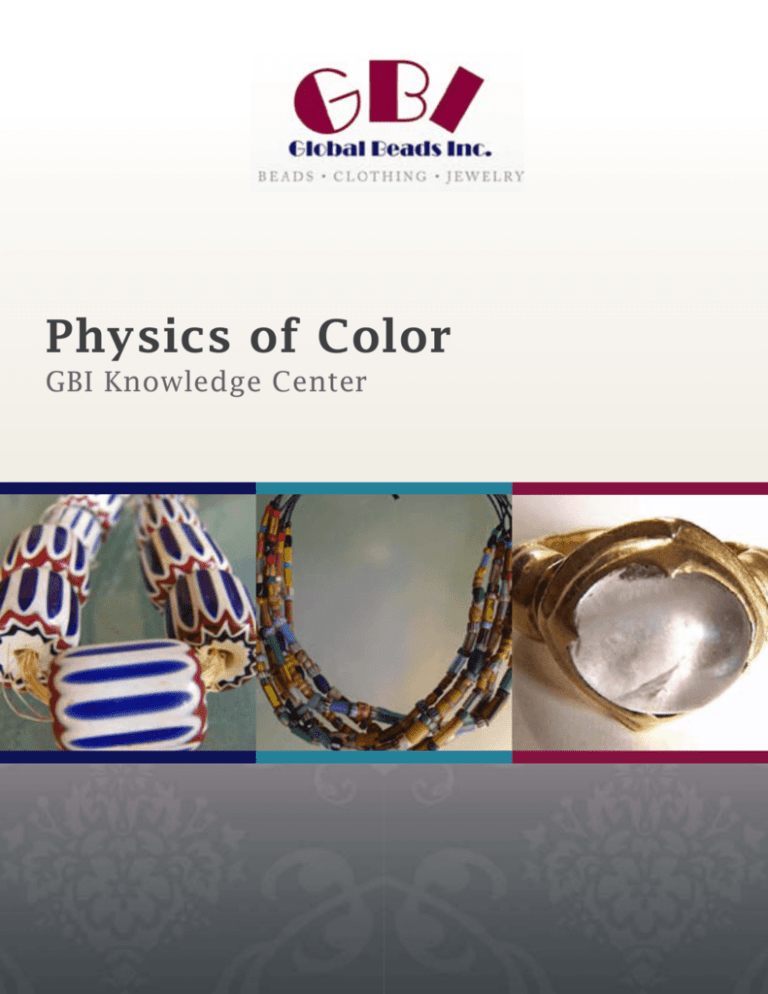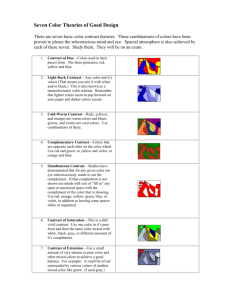Physics of Color - Global Beads, Inc.
advertisement

Physics of Color GBI Knowledge Center Technically speaking, colors are the way our brain, by use of our eyes, interprets electromagnetic radiation of a wavelength within the visible spectrum. Visible light lies between 400 and 700 nanometers. The different wavelengths are seen as different colors, as in the spectrum below. You see a spectrum like this everything you see a rainbow. Traditionally the spectrum is divided into seven separate bands. The first person to really define this was Newton. Some people believe that he included the color indigo only to make seven steps to match the number of notes in major musical scale. These are the approximate wavelengths for each of the colors: Color Red Orange Yellow Green Blue Indigo Violet Source: Johannes Itten - The Art of Color Wavelength (nm) 650 - 800 590 - 640 550 - 580 490 - 530 460 - 480 440 - 450 390 - 430 A Color wheel or color circle is either: • An abstract illustrative organization of color hues around a circle that show relationships between primary colors, secondary colors, complementary colors, etc. • A mechanical device that rotates an array of colors arranged as petals or gradients around an axis. Some sources use the terms color wheel and color circle interchangeably; however, one term or the other may be more prevalent in certain fields or certain versions as mentioned above. For instance, some reserve the term color wheel for mechanical rotating devices, such as color tops or filter wheels. Others classify various color wheels as color disc, color chart, and color scale varieties. Physics of Color | Global Beads, Inc. | www.globalbeads.com | 2 As an illustrative model, artists typically use red, yellow, and blue primaries (RYB color model) arranged at three equally spaced points around their color wheel. Printers and others who use modern subtractive color methods and terminology use magenta, yellow, and cyan as subtractive primaries. Intermediate and interior points of color wheels and circles represent color mixtures. In a paint or subtractive color wheel, the “center of gravity” is usually (but not always) black, representing all colors of light being absorbed; in a color circle, on the other hand, the center is white or gray, indicating a mixture of different wavelengths of light (all wavelengths, or two complementary colors, for example). The arrangement of colors around the color circle is often considered to be in correspondence with the wavelengths of light, as opposed to hues, in accord with the original color circle of Isaac Newton. Modern color circles include the purples, however, between red and violet. Color scientists and psychologists often use the additive primaries, red, green and blue; and often refer to their arrangement around a circle as a color circle as opposed to a color wheel. History An in-depth history of the color circles, wheels, spirals, triangles, charts, and other order systems has been published, as a chapter of an e-book, by Sarah Lowengard, focusing on the eighteenth century. Physics of Color | Global Beads, Inc. | www.globalbeads.com | 3 A typical artists’ paint or pigment color wheel includes the blue, red, and yellow primary colors. The corresponding secondary colors are green, orange, and violet. The tertiary colors are red– orange, red–violet, yellow–orange, yellow–green, blue–violet and blue–green. A color wheel based on RGB (red, green, blue) or RGV (red, green, violet) additive primaries has cyan, magenta, and yellow secondaries (cyan was previously known as cyan blue). Alternatively, the same arrangement of colors around a circle can be described as based on cyan, magenta, and yellow subtractive primaries, with red, green, and blue (or violet) being secondaries. Most color wheels are based on three primary colors, three secondary colors, and the six intermediates formed by mixing a primary with a secondary, known as tertiary colors, for a total of 12 main divisions; some add more intermediates, for 24 named colors. Other color wheels, however, are based on the four opponent colors, and may have four or eight main colors. Goethe’s Theory of Colours provided the first systematic study of the physiological effects of color (1810). His observations on the effect of opposed colors led him to a symmetric arrangement of his color wheel, “for the colours diametrically opposed to each other… are those that reciprocally evoke each other in the eye.” (Goethe, Theory of Colours, 1810). In this, he anticipated Ewald Hering’s opponent color theory (1872) . The Color Circle and Color Vision A color circle based on spectral wavelengths appears with red at one end of the spectrum and violet at the other. A wedge-shaped gap represents colors that have no unique spectral frequency. These extra-spectral colors, the purples, form from additive mixture of colors from the ends of the spectrum. In normal human vision, wavelengths of between about 400 nm and 700 nm are represented by this incomplete circle, with the longer wavelengths equating to the red end of the spectrum. Complements are located directly opposite each other on this wheel. Physics of Color | Global Beads, Inc. | www.globalbeads.com | 4 These complements are not identical to those in pigment mixing (such as are used in paint), but when lights are additively mixed in the correct proportions appear as a neutral grey or white. The color circle is used for, among other purposes, illustrating additive color mixture. Combining two colored lights from different parts of the spectrum may produce a third color that appears like a light from another part of the spectrum, even though dissimilar wavelengths are involved. This type of color matching is known as metameric matching. Thus a combination of green and red light might produce a color close to yellow in apparent hue. The newly formed color lies between the two original colors on the color circle, but they are usually represented as being joined by a straight line on the circle, the location of the new color closer to the (white) centre of the circle indicating that the resulting hue is less saturated (i.e., paler) than either of the two source colors. The combination of any two colors in this way are always less saturated than the two pure spectral colors individually. Objects may be viewed under a variety of different lighting conditions. The human visual system is able to adapt to these differences by chromatic adaptation. This aspect of the visual system is relatively easy to mislead, and optical illusions relating to color are therefore a common phenomenon. The color circle is a useful tool for examining these illusions. Arranging spectral colors in a circle to predict admixture of light stems from work by Sir Isaac Newton. The psychophysical theory behind the color circle dates to the early color triangle of Thomas Young, whose work was later extended by James Clerk Maxwell and Hermann von Helmholtz. Young postulated that the eye contains receptors that respond to three different primary sensations, or spectra of light. As Maxwell showed, all hues, but not all colors, can be created from three primary colors such as red, green, and blue, if they are mixed in the right proportions. The Young–Helmholtz theory is still seen as the most effective in modeling human color vision though the color vision system is far more complex than differences in the retina alone, with different cells in the lateral geniculate nucleus also responding in opponent fashion to complementary colors, and further color coding occurs in the visual cortex. Physics of Color | Global Beads, Inc. | www.globalbeads.com | 5 Color Wheels and Paint Color Mixing There is no straight-line relationship between colors mixed in pigment, which vary from medium to medium. With a psychophysical color circle, however, the resulting hue of any mixture of two colored light sources can be determined simply by the relative brightness and wavelength of the two lights, a similar calculation cannot be performed with two paints. As such, a painter’s color wheel is indicative rather than predictive, being used to compare existing colors rather than calculate exact colors of mixtures. Because of differences relating to the medium, different color wheels may be created according to the type of paint or other medium used, and many artists make their own individual color wheels. These often contain only blocks of color rather than the gradation between tones that is characteristic of the color circle. The Twelve Major RGB/HSV Color-wheel Colors The RGB-based HSV color wheel (left) and the 3D conical HSV space that it represents (right). Primary, secondary, and tertiary colors on the RGB color wheel. The HSL and HSV color spaces are based on the RGB color space, in which the twelve primary, secondary, and tertiary colors are spaced at 30 degree hue angles, corresponding to where one or two RGB coordinates is at the maximum (255), one or two is at the minimum (0), and in the case of the tertiary colors, one may be at half-scale (127). The saturation of these colors is at the maximum (1) in both HSL and HSV, and in HSV space the value is at maximum (1). Physics of Color | Global Beads, Inc. | www.globalbeads.com | 6 The six primary and secondary colors of this color wheel are named in the web colors and X11 colors. The additive primaries, red, green (web color lime), and blue, are the primary colors of this color wheel. The subtractive primaries, yellow, cyan (aqua), and magenta (fuchsia), are its secondary colors. The tertiary colors have no consistent set of web color names: orange (not the same as web color orange), the web color chartreuse (chartreuse green), spring green, azure (not the same as the web color), violet (not the same as the web color), and rose (no named X11 or web color) are the tertiary colors of the HSV color wheel. Physics of Color | Global Beads, Inc. | www.globalbeads.com | 7






